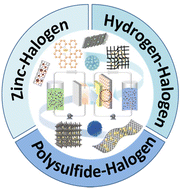Cathode materials for halide-based aqueous redox flow batteries: recent progress and future perspectives
Abstract
As the population increases sharply around the globe, huge shortages are occurring in energy resources. Renewable resources are urgently required to be developed to satisfy human demands. Unlike the lithium-ion batteries with safety and cost issues, the redox flow battery (RFB) is economical, stable, and convenient for the development of large-scale stationary electrical energy storage applications. Especially, the aqueous redox flow battery (ARFB) further exhibits a promising potential in larger power grids owing to its unique structural features of storing energy by filling the tank with electrolytes. The ARFB is capable of modulating battery parameters by controlling the volume and concentration of the electro-active species (EAS). Further, halogens show excellent properties, such as low cost and appropriate potential as an EAS for ARFB, further showing an efficient, safe, and affordable energy storage system (ESS). Moreover, to attain the demands of strong activity, high sensitivity, convenience as well as practicality, further attention needs to be paid to material (electrode) design and adjustment. In this mini-review, novel electrode materials, including their potential internal mechanisms and effective regulatory means, are summarized and applied in the zinc-halogen, hydrogen-halogen, and polysulfide-halogen ARFB systems, promoting the development of valuable material systems and the innovation of the energy storage/conversion technologies.

- This article is part of the themed collections: Recent Review Articles and Nanoscale 2023 Emerging Investigators


 Please wait while we load your content...
Please wait while we load your content...